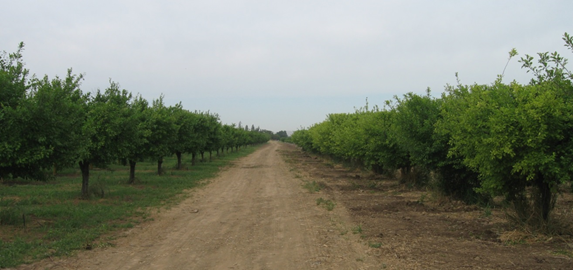Wet springs often means more yellow, iron (Fe) deficient prune trees than in dry years. Iron deficient prune trees show yellow leaves with green veins and limited vigor. If the deficiency continues, the leaf between the veins bleaches to almost white. The symptoms usually appear first at shoot tips, because iron is not mobile in plants. Tree growth and production can suffer under extended Fe deficiency.
The problem is actually not soil Fe deficiency, but a lack of iron in the right form within trees. Researchers believe Fe deficiency in tree crops is related to soil bicarbonate levels. To further complicate troubleshooting of yellow leafed prune trees, leaf analyses results may not show low leaf Fe levels, but Fe deficiency symptoms will be present. This is because, while prune trees absorb Fe as Fe2+, it must be oxidized to Fe3+ in the tree to be biologically useful. If the shift from Fe2+ to Fe3+ doesn’t occur, Fe can be in the leaf and measureable by lab equipment but not active in chlorophyll molecules and other important functions, resulting in yellow leaves.
While foliar sprays containing Fe3+ can correct symptoms in the short-run, the root cause of the problem of yellow prune trees is elevated soil bicarbonate and that is the condition to be managed in the long term. Soil bicarbonate levels can be elevated by several conditions; some are more easily managed than others.
Alkaline soils (pH > 7.0) are high in carbonates and bicarbonates. The further above pH 7, the greater the level of carbonates and bicarbonates in soil. Areas in an orchard can show high pH and iron deficiency symptoms. Yellow leaves from iron deficiency are often called iron chlorosis or lime induced iron chlorosis. Reducing the soil pH with soil sulfur or sulfuric acid applications is a method of correcting lime induced iron chlorosis. Adding sulfur is a slower, longer lasting effect, while adding sulfuric acid is a quick, short-lived fix. In some orchards with very high pH and excessive yellowing in trees, shanking sulfur into the ground gives the best results. If not treated, Fe deficiency symptoms will continue through the season as the source of bicarbonate is permanent.

Two prune orchards, farmed by the same operation. The orchard on the right is irrigated with high bicarbonate water.
Irrigation water high in bicarbonates can produce yellow trees (see photo above). This can be corrected with sulfuric acid or urea/sulfuric acid treatment of the irrigation water or by sulfur application to the soil to reduce soil pH to neutralize the bicarbonate. Unless treated, this condition can continue through the season, especially in areas of the orchard where pH is above 7.
Saturated soils after bloom, which can result from premature irrigation in wet springs, can accumulate bicarbonate from the carbon dioxide produced by respiring roots and trapped in the soil by excessive moisture. The best correction for this condition is timely irrigation. In this scenario, the yellow leaves should fade as the soil dries and allow to “breathe out” the carbon dioxide.
Finally, the best long-term fix for iron deficiency in prunes and other stone fruit is the use of rootstocks that perform well under high bicarbonate soil conditions. Rootpac-R is a rootstock that is reported to do well under high pH soils in Europe and may have a fit under similar conditions in California prune orchards. This rootstock is included in the Yuba County prune rootstock trial planted by UC in 2011. So far, the trees are performing well. Stay tuned…


Leave a Reply